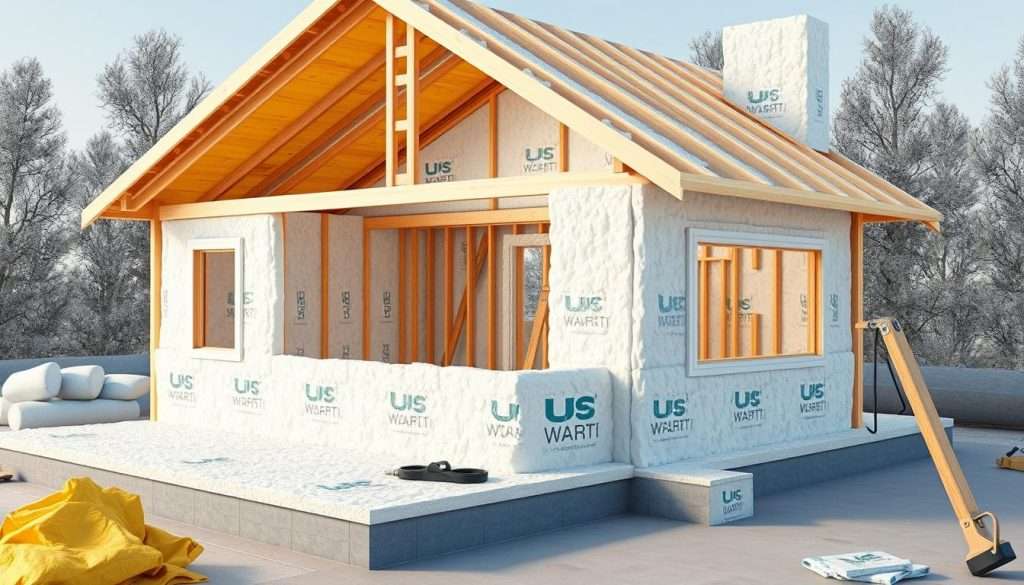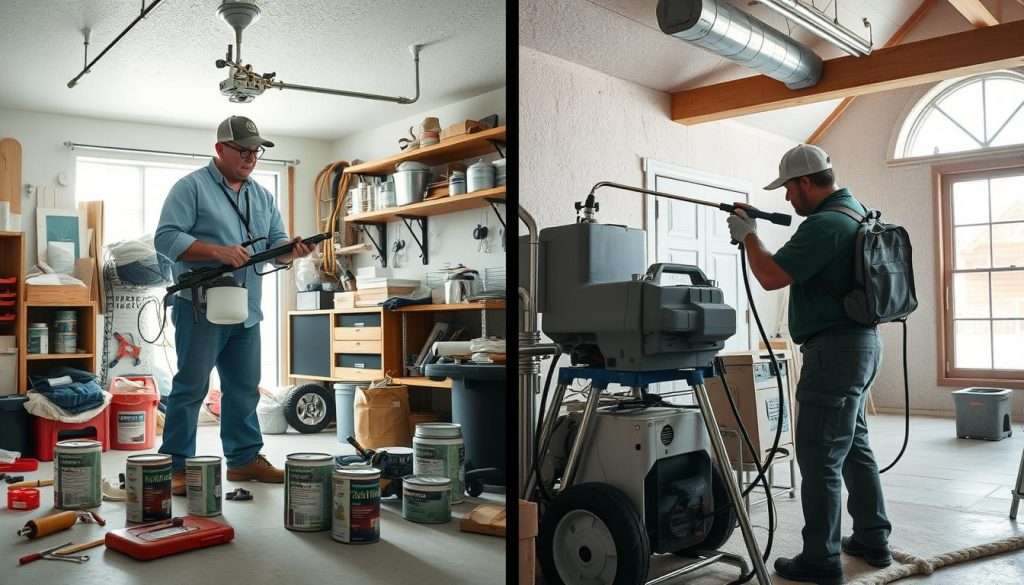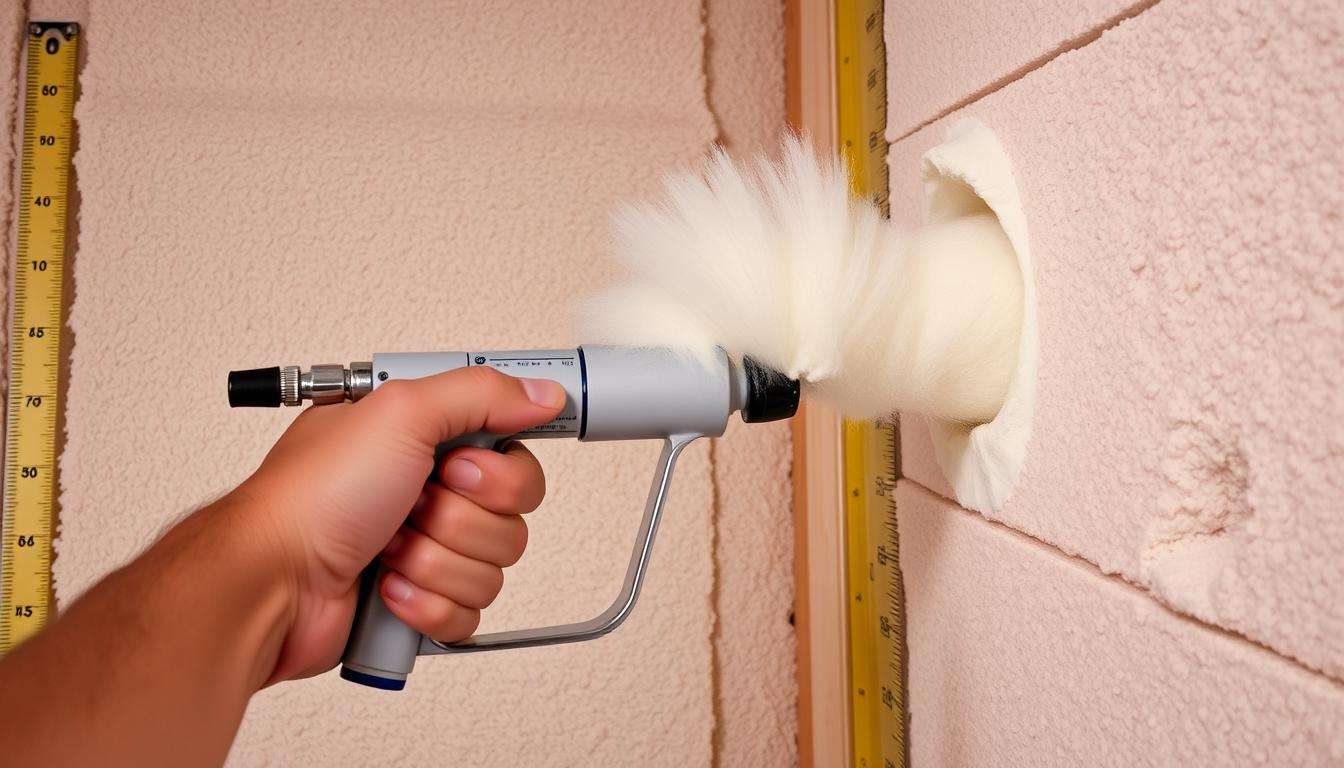Knowing how much does spray foam insulation cost is key for homeowners. It helps you make your home more energy efficient. This 2024 Price Guide helps you understand the costs and what affects them. You’ll see if the cost of spray foam insulation is worth it for your home.
Spray foam insulation prices can be between $1.00 and $4.50 per square foot. The total cost to install is usually between $1,300 and $4,000. Knowing these numbers helps you decide on insulation for walls, attics, or garages.
Key Takeaways
- The average cost of spray foam insulation ranges from $1,300 to $4,000 installed.
- Prices for spray foam can vary significantly based on factors like type and application area.
- Understanding the installation costs is essential for budget planning.
- Informed decisions can lead to better energy efficiency and long-term savings.
- Comparing DIY vs professional installation can affect overall costs.
Overview of Spray Foam Insulation Costs
Homeowners need to know about spray foam insulation costs. It’s key for making homes more energy-efficient. This choice is good for comfort and saving energy too.
What is Spray Foam Insulation?
Spray foam insulation is a liquid that grows to fill gaps. It’s made of polyurethane and isocyanate. It’s great for keeping your home warm or cool.
Benefits of Spray Foam Insulation
- Energy Efficiency: It helps save on energy bills by keeping heat in or out.
- Durability: It lasts up to 80 years, offering long-term benefits.
- Moisture and Air Barrier: It keeps moisture out and air quality in.
Factors Influencing Cost
Several things affect the cost of spray foam insulation:
- Type of Foam: Open-cell foam is cheaper than closed-cell because it’s less dense and lets water through.
- Project Size: Bigger projects cost less per square foot, making them more affordable.
- R-Value: Higher R-Values mean better insulation but cost more.
The cost to install spray foam insulation is between $1.50 and $5.00 per square foot. This depends on local labor, materials, and the project’s size.
Types of Spray Foam Insulation
There are two main types of spray foam insulation: open-cell and closed-cell foam. Each has its own benefits and is best for different uses. The right choice affects how well it insulates and the cost per square foot.
Open-Cell vs. Closed-Cell Foam
Open-cell and closed-cell foams meet different needs:
- Open-Cell Foam: It’s less dense, with an R-value of about 3.5 per inch. Costs are $0.35 to $0.55 per board foot. It’s good for inside spaces and is cheaper.
- Closed-Cell Foam: It’s denser, with an R-value of 6.0 to 7.0 per inch. Costs are $0.90 to $1.50 per board foot. It’s best for wet areas like basements.
Cost Differences Between Types
The price difference between these foams affects your insulation cost:
| Type of Foam | Average Cost per Board Foot | R-Value | Ideal Application |
|---|---|---|---|
| Open-Cell Foam | $0.35 – $0.55 | 3.5 – 3.8 per inch | Interior Spaces |
| Closed-Cell Foam | $0.90 – $1.50 | 6.0 – 7.0 per inch | Moisture-Prone Areas |
Costs vary for installation. Open-cell foam costs $1 to $3 per square foot. Closed-cell foam costs $1.50 to $4 per square foot, depending on thickness and needs.
Average Cost to Install Spray Foam Insulation
Knowing the cost to install spray foam insulation helps homeowners plan. The cost varies based on the type of foam and the home’s size.
National Average Costs
The cost to install spray foam insulation is about $6,080 on average. For a 2,000-square-foot home, it can cost between $2,000 and $8,000. Here’s a cost breakdown for different areas:
| Area | Cost Range |
|---|---|
| Attics | $1,100 – $6,800 |
| Basements | $1,500 – $5,600 |
| Crawl Spaces | $1,200 – $6,700 |
Cost per Square Foot Breakdown
The cost per square foot is between $1.50 and $5.00. This includes both the foam and the cost to install it. The type of foam affects the cost:
- Open-cell foam: $0.35 to $0.55 per board foot
- Closed-cell foam: $0.90 to $1.50 per board foot
For example, insulating a 1,000-square-foot attic can cost between $1,500 and $4,500. Closed-cell foam is more expensive but better at keeping moisture out and saving energy.

Additional Costs to Consider
When planning your spray foam insulation project, it’s crucial to look beyond material costs. Installation brings in several additional expenses that can influence the overall project budget significantly.
Labor Costs
The labor costs for spray foam installation typically range between $1,500 and $4,500. This variance depends on factors such as the complexity of the project and geographical location. On average, contractors charge between $1.50 and $4.90 per square foot for their services.
Homeowners should also account for potential increases in labor costs if drywall removal becomes necessary. This could add an extra $293 to $875 to the total.
Equipment Rental Fees
The associated equipment rental fees for spray foam insulation can further impact your budget. Renting equipment like a foam insulation machine generally costs between $200 and $300. Deciding whether to rent or purchase equipment should be based on project scope and frequency of use.
Be sure to incorporate these costs when estimating the total spray foam insulation installation cost.
Permitting and Inspection Fees
In some cases, securing the necessary permits and scheduling inspections may become a requirement, particularly for larger projects. These fees can range from several hundred dollars and should be considered in your budget. Understanding local building codes can help you avoid unexpected charges.
For additional insights into factors affecting insulation costs, feel free to explore this resource.
Pricing by Location
Knowing the cost of spray foam insulation is key for homeowners. You’ll see big regional cost variations for spray foam insulation. This is because of where you live.
City areas usually cost more because there’s more demand. But, in the countryside, prices are lower. This is because there’s less demand and lower labor costs.
Regional Cost Variations
Prices for spray foam insulation vary across the United States. For example, East Coast cities might cost up to $15,600. This is because of high labor costs and other local expenses.
But, in rural areas, prices can be as low as $2,225. This big difference shows how important location is when planning insulation.
Urban vs. Rural Pricing Differences
The cost difference between urban vs rural spray foam installation costs is big. In cities, you might face:
- Higher labor rates
- Extra fees for getting to your place
- Prices go up because there’s more competition
In contrast, rural areas might have:
- Cheaper labor costs
- Less competition and demand
- Lower costs because of fewer problems getting to your place
These factors shape the cost of insulation across the country. Thinking about your location helps you plan your budget better.
| Location | Average Cost | Factors Affecting Cost |
|---|---|---|
| East Coast Urban Areas | $15,600 | High labor rates, accessibility issues |
| Midwest Urban Areas | $10,000 | Moderate demand, average labor rates |
| Rural Areas | $2,225 | Low demand, reduced labor costs |
DIY vs. Professional Installation
Choosing between DIY and professional spray foam insulation is a big decision. You need to think about the costs and benefits of each. Knowing the financial side helps you pick the right choice for your project.
Cost Comparison of DIY and Professional
DIY spray foam kits cost about $400 and cover 200 board feet. This means it costs about $2 per board foot. For bigger areas, you might spend $500 to $2,000 for 1,000 sq ft, depending on the foam and kit.
Professionals charge between $1.00 to $4.50 per square foot. DIY saves on labor costs but you need to buy PPE and equipment for better quality.
Pros and Cons of Each Option
- DIY:
- Cost-effective for small projects and no labor fees.
- Flexible timing lets you work at your own pace.
- Requires a lot of time for installation and research.
- May face challenges with equipment quality and off-ratio foam.
- Spending $100 to $200 on PPE is needed for safety.
- Professional:
- Higher upfront costs but ensures quality and code compliance.
- Uses advanced equipment, costing $60,000 to $100,000, for better results.
- Professionals work faster, saving time.
- Experts handle off-gassing and safety measures.

Thinking about these points helps you choose the best option for your home.
Long-Term Savings with Spray Foam Insulation
Getting spray foam insulation is a smart move. It saves money over time. It makes your home more energy-efficient, which is great for saving money.
Energy Efficiency Benefits
Spray foam insulation is very good at saving energy. It can make a new home 30% more efficient than old insulation. For homes already built, it can cut energy costs by up to 50%.
Insulating your attic can lower your energy bills by 50% each month. This means big savings over the years. It also makes your HVAC system work better.
Return on Investment Over Time
The cost of spray foam insulation, about $4,000 for attics, pays off in three years. You can save almost $4,000 on energy bills in 32 months. This shows how spray foam insulation saves money over time.
It makes your home more comfortable too. We suggest insulating your whole home. This stops air leaks and makes your HVAC system work better.
Incentives and Rebates Available
Homeowners looking into spray foam insulation can find many financial perks. These perks help lower the cost upfront and save energy in the long run. It’s key to know about these options to get the most from your energy-saving efforts.
Federal and State Tax Credits
Many homeowners can get big spray foam insulation tax credits from the federal and state governments. The federal government gives a 30% tax credit for making homes more energy-efficient. This includes up to $1,200 for insulation upgrades. Here are some key points about these tax credits:
- Annual total limit of $3,200 for efficiency tax credits.
- Maximum of $1,200 for any combination of home envelope improvements, including insulation.
- Tax credit of $2,000 available for heat pump installations.
- Additional credits for window and door replacements that can total up to $600.
- Potential $500 tax credit for replacing two or more doors.
Local Utility Company Rebates
Local utility rebates also offer savings for insulation upgrades. Many utility companies give money back to encourage energy-saving home improvements. These local utility company rebates can help lower the cost of installation. They offer several benefits:
- Many programs provide upfront costs reductions during installation.
- Rebates can cover a significant percentage of the overall project cost.
- Always check local requirements to maximize your savings and ensure eligibility.
Using these incentives can greatly reduce your costs and improve your home’s energy use. Knowing about tax credits and local programs helps you get the most from your investment. Always talk to a tax expert or your local utility to find out what you qualify for.
Tips for Choosing an Insulation Contractor
Choosing the right insulation contractor is key for a good spray foam insulation job. A good contractor has lots of experience and knows how to handle the job well. Think about what makes a contractor great for your project.
What to Look for in a Contractor
When picking an insulation contractor, look at these important things:
- Experience and Qualifications: Check if they have the right certifications. Look for ones from groups like the Spray Polyurethane Foam Alliance.
- References and Reviews: Find online reviews and ask for references. This helps you see if they do good work.
- Insurance: Make sure they have liability insurance. This keeps you safe if problems happen during the job.
Questions to Ask Before Hiring
Ask the right questions to make a smart choice. Here are some important ones:
- What types of spray foam insulation do you recommend for my project?
- Can you give me a detailed estimate and when you’ll finish?
- How do you deal with problems like overspray or equipment failure?
- What experience do you have with building sciences, and how does it help your work?
By asking these questions, you’ll choose a contractor who will do a great job.
